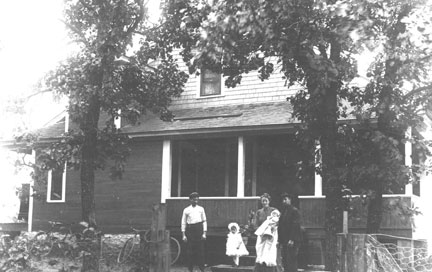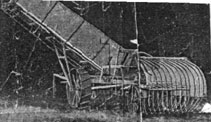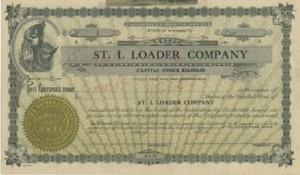Henry P. Hofstrand came from Sweden about 1893 and went to live with his aunt in Litchfield after her husband had died. A few years later, he worked in the woods near Hibbing , and in the spring of 1903 he returned to Minneapolis. He worked here for a time for the Minneapolis Furniture Company and then moved to St. Louis Park where he was employed by the Monitor Drill Company.
Henry purchased a lot at 7623 North Street in Oak Hill. He began building a home here at this address and when the great cyclone of 1904 struck the whole area, Henry, along with many others salvaged all of the lumber they could from the ruins of the old company houses which had belonged to the Sugar Beet Company. Many used this old lumber to build new homes. Henry’s was one of them.
In the basement of this home at North Street , Henry poured large round cement columns for support and on top of these he placed steel railroad tracks. This was the main support for the floor joists in this large two story house. This is perhaps one of the sturdiest built homes in all of Oak Hill. It is still standing even though there have been many additions over the last 100 + years.

Left to right, Peter Nelson, Evangeline Ruth Hofstrand, her mother Lina Hofstrand and holding baby Edward and on the right, H.P. Hofstrand. Photo circa 1907.
Henry invented a type of wheel bearing for the seeders that were being manufactured by the Monitor Drill company. He suggested this to the company and they said it was not feasible. A year or two later, the company began using this type of bearing. Henry sued the Monitor Drill company and eventually settled for about 500 dollars. After this he learned to patent his inventions.
By April, 1917 Henry had among other patents, one for a corn “Shock Loader” and he formed a corporation to begin to perfect and produce this farm implement. It was called “The St. L Loader Company”. The first meeting was held on April 19th, 1917. The first board of directors was named and elected on the 12th Day of January
Corn Shocks
Green Corn stalks were ground and used for cattle feed and stored in silos and was called silage. Corn stalks were cut and then chopped into about ½ inch pieces and stored in the silo while the moisture content was still high.
The remaining whole corn stalks were cut with a corn knife with the ears of corn still on the stalks and they were gathered and put into “Shocks.”
On some farms about every 7 to 10 corn stalks were cut, bundled, tied together and stacked. This was called a “Shock.” The amount of stalks might vary on different farms. A shock was typically made by standing the tied bundles of corn stalks into a conical or pyramidal type stack. In the early days the hired men or farm hands would make shocks about every 36 feet. Some farms when they were cutting the stalks by hand would leave one or two stalks standing every 12 steps so that when the shocks were made, they had some support to lean against. The corn ears were left attached to the stalks so that they could dry over time. They could later be taken into a building and the ears shucked off of the stalks when times were not so busy around the farm. The stalks were chopped and fed to cattle or sheep and they loved it. On some farms, the hired men would do the cutting, tying and stacking and were paid by the shock. A cord or rope might be wrapped around the whole shock and when ready to bring in from the fields, they could be put into a shock loader and hauled away by truck. Shocks could weigh anywhere from 40 to 50 pounds.
After the corn was shucked from the stalks it could be stored in corn bins or shelled and kept in a separate building where the rats and mice were hard put to get at it. In later years with the advent of the horse drawn corn binder it was just a matter of standing the bundles to make a shock. No hand cutting was necessary.
The St. L Loader Company
The company’s petition for Charter was dated February 27th, 1907. The St. L Loader Company was incorporated in April, 1917. The company was located in a neighborhood known as Oak Hill at 7623 North Street. Henry P. Hofstrand had among other patents, one for a corn “Shock Loader” and for which he formed this corporation to begin to perfect and produce this farm implement.
The first meeting was held on April 19th, 1917. The initial number of shares issued was 1900. Stocks were valued at $2.00 per share when subscribed for. $4.00 per share on January 1st, 1918 $4.00 per share on January 1st, 1919.
Wages paid the officers shall not be more than the Union scale paid the metal and woodworker trades. Compensation for services as officers shall be at the rate of 35 Cents per hour.
The first board of directors was named and elected on the 12th Day of January. The directors, holding one year terms, were Henry P. Hofstrand, Gustav Anderson, and James M. Boss.
Some of the various directors of the company were well known prominent men of St. Louis Park such as Henry P. Hofstrand, founder and Wayne P. Martin, Gust Anderson, James M. Boss, Jake Werner, Eric Liljenfors, D.C Martin, Hulda Hofstrand and Verner G. Lindahl,
|
STOCKHOLDER |
FROM |
SHARES OWNED |
|
Hulda Hofstrand |
St. Louis Park |
905 |
|
Henry P. Hofstrand |
St. Louis Park |
954 |
|
Gustav Anderson |
St. Louis Park |
900 |
|
Walter F. Williams |
Escanaba, Mich. |
60 |
|
Richard Carlson |
Finmark, Ontario |
27 |
|
Dr. James Blake |
Hopkins |
5 |
|
Eric Liljenfors |
St. Louis Park |
10 |
|
Gust Miller |
St. Louis Park |
5 |
|
St. Louis Park |
10 |
|
|
D.C. Martin |
St. Louis Park |
10 |
|
Gustav Olson |
St. Louis Park |
10 |
|
Victor E. Johnson |
St. Louis Park |
5 |
|
Verner Lindahl |
St. Louis Park |
25 |
|
Alex Carlson |
Excelsior, Minn. |
5 |
|
J.R. Resslor |
Minneapolis |
5 |
|
Victor Messner |
St. Louis Park |
5 |
|
A.H. Miller |
St. Louis Park |
5 |
|
St. Louis Park |
5 |
|
|
John Erickson |
St. Louis Park |
5 |
|
John E. Lewis |
St. Louis Park |
5 |
|
James M. Boss |
St. Louis Park |
5 |
|
O.M. Osthend |
Unknown |
23 |
|
John Anderson |
Port Arthur, Ontario |
|
I recall the rear wheels of the loader being stored in our barn for years. They were steel wheels with lugs and were about 5 feet in diameter and almost 12 inches in width with metal spokes. They were quite heavy I know. I am including the only known facsimile of the Shock Loader. I also have the corporation book ledger. If the society is interested I would donate them to the St. Louis Park Historical Society. I donated a few items years ago to Marie Hartman for the Society.

According to the records and stories I heard from my family about the St. L Loader company, they had a major problem with the weight of the machine and it getting through the fields when they were soft after a rain. They decided to try a wooden model in order to lighten the machine. The price of aluminum and technological costs made it prohibitive for its use.
The following is from the books of the company report at the annual meeting on January 8th, 1921:
President Henry P. Hofstrand reported that several important changes in the construction of the Loader have been made during the past year and a small model is being made for demonstration and advertising purposes. No effort has been made to put the machine on the market because of the financial conditions.
Gust Anderson reported he had been engaged in perfecting the model during the past year which would be ready for the next season’s demonstrations.
I found very little information regarding the construction after this date. Finally in 1926, the corporation decided to go out of business. The last record I have is that the doors were closed some time in 1926 due to excessive costs and the inability to lighten the loader enough to use in all field conditions.
All of the Stockholders were eventually paid for their outstanding shares. Henry worked for several years to pay off the investments of the stockholders. The last to be paid off was Jake Werner and when Henry knocked on his door to give him the last payment, Jake was quoted as saying, ”I can throw away the lantern; I have finally found an honest man.”

